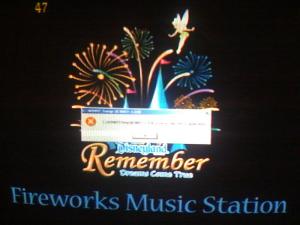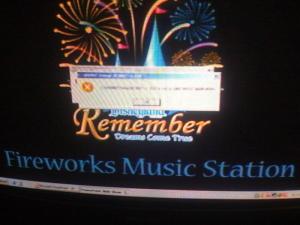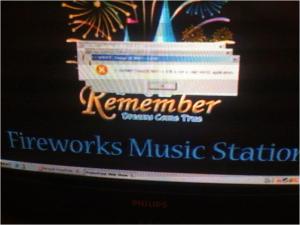Just got back from the STAR West conference, where I was lucky enough to have been chosen to do a keynote. As often happens when I do testing talks, I got an epiphany the night before — an anchoring idea to frame my talk and make it more memorable.
The conference was at the Disneyland Hotel. They have their own series of TV channels there, one of which is the Fireworks Music Channel (channel 47 if you stay at the hotel). I noticed this when flipping around the channels trying to find one of the many Disney stations so that my 2-year-old daughter Charlotte could get in some Mickey Mouse time before she met him in person.
I happened upon channel 47, which was a static image of the Magic Kingdom with a black background, with Disney soundtrack music playing softly. That was it. All day, all night, music playing softly with an image of the Magic Kingdom — perhaps for weary parents or children who need to wind down from being over-stimulated by rides and sugar.
Handy to know, but we had just arrived, so little Charlotte was ready to wind up, not wind down.
We found a channel with the Mickey Mouse Club and she was happy.
The next morning, Sunday morning, was quiet, and with Charlotte still asleep in the bed next to mine with my wife, I wanted to start my day quietly — no news, no Mickey Mouse Club, just quiet music. I remembered Channel 47.
I flipped to it and saw this:
Nice! Finding bugs is my business, but sometimes they find *me*.
I took a picture of the error to use in a testing class one day.
The next day, I was flipping through the channels, and saw this:
The story had unfolded a bit — two error dialogs which appear to say the same thing: “<unintelligble path” is not a valid win32 application” and I noticed the menu bar at the bottom with the system tray. It was PowerPoint that was failing.
The next day:
That’s right… 3 error dialogs. One per day? Clearly, no one at the hotel is looking at this.
The next day was my keynote, titled “Telling Your Exploratory Story” and I knew I had my hook — a way to anchor my talk about how to describe the flow of thinking when there’s no test script to follow. I would use this as an example that sometimes details slowly reveal themselves, and it’s the thinking about the new, emerging context (and how you react to it) that really underscores the art and craft of exploratory testing — telling your story of the dynamic things that happened in your testing and what you did about it.
Thinking that it was a date-driven bug — perhaps midnight being the trigger — I checked channel 47 one more time before going to bed just after midnight on Day 4.
I saw this:
Cool. Four dialogs, four days.
The day of my keynote, I told the front desk. After some trouble explaining that it was not my TV or my laptop, (and no, a technician does not need to be sent to my room) I felt that I had done my civic duty as a tester — reporting a problem in such a way that it had a likelihood of getting fixed.
I added the pictures to my keynote slides and kicked off my talk with them, saying that sometimes a bug story unfolds without us having to do anything but collect context. It enhanced my talk, I think — got some good laughs and made my point.
A good keynote sets the tone for the conference — grounds the attendees to a meaningful social meme. And sure enough, for the rest of the week, I had evidence that my talk did exactly that. People came up to me the next day and asked me what was happening with Channel 47. I told them it was fixed because I did not see any dialogs that next day.
But someone came up to me the day after that and said they saw the error return. I checked and confirmed it. One error dialog. But later that evening, well before midnight, there were two dialogs, blowing my theory that midnight was the driving event.
I mentioned this at a separate talk I was doing the next day. Someone in the audience pointed out there is also a Disney site in Florida, not just California, and if the channel was hosted at Disney World in Orlando, it would be three hours ahead, meaning that it still could be driven by midnight!
But it was the final day of the conference that was the critical incident for me. I was in the front row of Rob Sabourin‘s talk titled “Toward an Exploratory Testing Culture.” He talked about ways testers could find things in common like how to add value to a project, how to be a bug advocate, how to represent their work in credible ways. He invited discussion from the audience of about 250 people. And then it hit me. I had a two-word comment that to me, was an iconic example of an exploratory testing culture — something that grounded us that week, bonded the attendees into a common story, that got people out of their boxes and shells and compartments for just a little while to think about one common, curious, critical problem.
Channel 47.
“What’s going on with Channel 47 today, Jon?”
“I didn’t see the error today, Jon. Did you?”
“I can’t get Channel 47 at all here at the hotel, I called the front desk to see what the deal was.”
“What do you think the invalid win32 application is, Jon?”
“I saw something similar in the hotel elevator — it appeared to be a digital test pattern underneath the floor indicator.”
“I like that theory that the server is based in Florida.”
“Why do you think the title bar doesn’t show until day two of the problem?”
It was these comments that made me feel connected to everyone else at the conference. I was the just vehicle for the culture, which, like the bugs that exist in the software that’s delivered to us, was already there, waiting to be discovered.




October 8, 2008 at 3:59 pm |
Thanks for bringing this story to parts of world who couldn’t make it to Star West.
As an exploratory tester, I actively update myself with such stories of bugs because it helps me ask a question like “Can there be a bug like the Channel 47 one in this application I test?” and that gives rise to new ideas to test and probably similar bugs that I might encounter. So, definitely Channel 47 adds to my kitty of questions and oracles.
BTW, a very small smiley at the bottom of the page is interesting 🙂
October 8, 2008 at 6:49 pm |
Thanks for a very interesting incident. I enjoyed the fact that we as testers will come up with many bug theories, most may be wrong, But it’s a great learning exercise.
October 8, 2008 at 10:31 pm |
Yay! You have a blog! I was at the conference – and was in all of the above mentioned talks – that was a really fun thread that you wove through it. This was my first time at a conference and I loved the fact that there was such a sense of community – so many like-minded individuals.
Cool first post – thanks again for all of the inspiring info.
October 9, 2008 at 7:44 am |
Welcome to the blogosphere. I await your further elevation in the pantheon of sane software test :).
May 21, 2009 at 4:17 am |
Yeah, well… so much for being elevated. I’m stuck in 2008 tonight. Gotta do better with my replies.
November 3, 2008 at 8:31 am |
Welcome to the blogging world. Nice to see you took up your brothers call for more testing blogs! Good posts so far. Hope the long pauses inbetween posts are not hereditary (@James ;-).
If you need some pointers to do a bit more with your WordPress blog let me know.
May 21, 2009 at 4:12 am |
Too late. 🙂 Feel free to give me pointers, or a kick in the butt. I have no good excuse for waiting so long to reply to posts or add a new one. I have a love-hate relationaship with writing. Today, I’m feeling like a good blogger…
November 20, 2008 at 3:52 am |
Jon, nice post, I like your keynotes presentation in StarWest, that’s one of the best.
Also, the card game in your course about exploratory testing is unforgettable. Wow, I like it.
May 21, 2009 at 3:49 am |
Thanks, Jia. I got the idea from James who got it from Payson Hall. I just heard about a game called Zendo which is a rule-based game very similar to the exploratory card game (called “Art Show”, by the way).